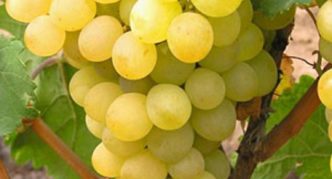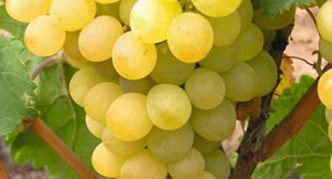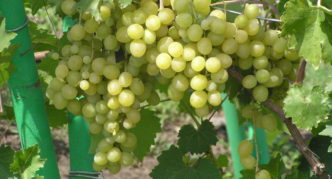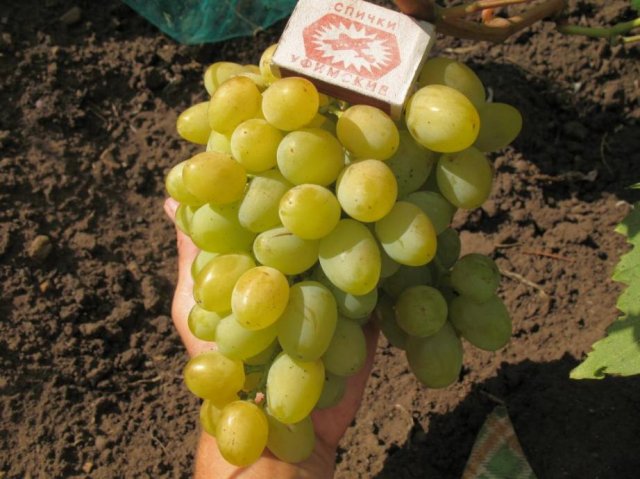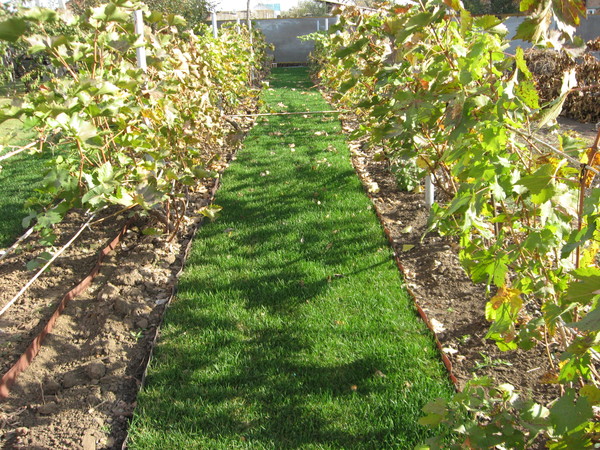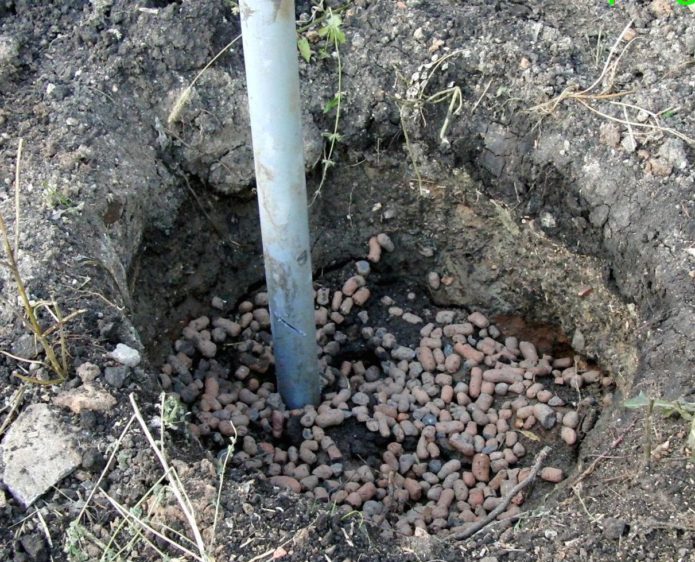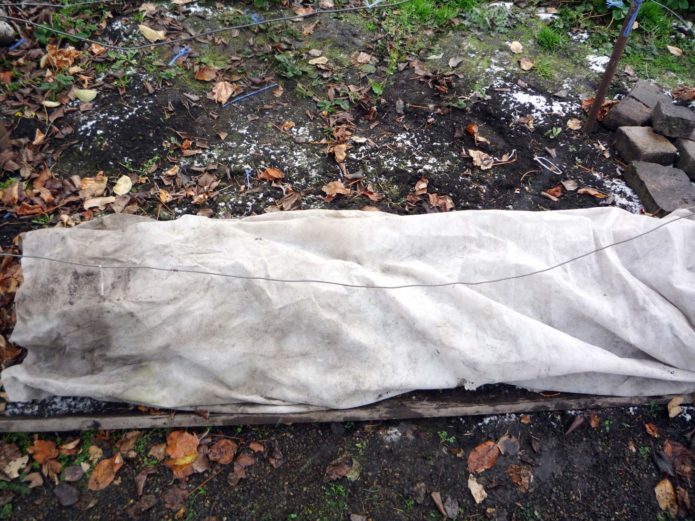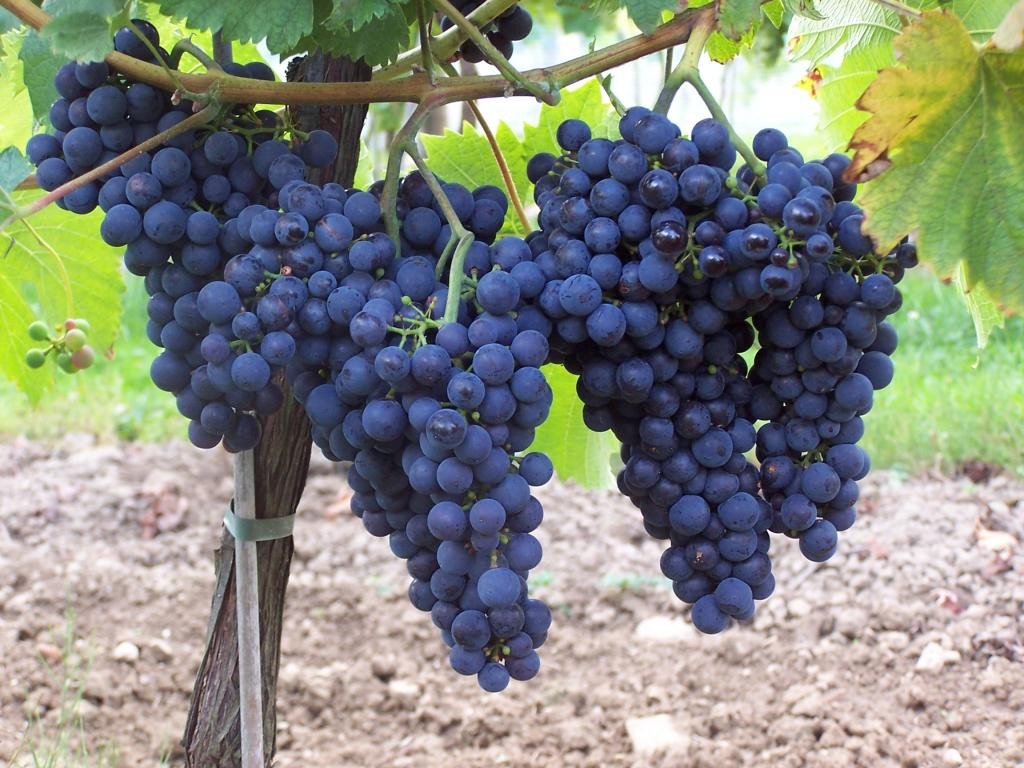Breeders pay much attention to the development of new grape varieties that tolerate the cool climate of temperate latitudes well. As a result of their fruitful work, this culture has spread far north of its usual range. Galahad is one of the brightest representatives of modern cold-resistant grape varieties. It grows well and bears fruit in most of the territory of our country, with the exception of the regions of the Far North.
Content
Galahad grape cultivation history
Galahad was bred by specialists from the V.I. Ya. I. Potapenko (the city of Novocherkassk) specially for cultivation in the middle lane and other regions with a temperate climate, by crossing three varieties: Talisman (Kesha), Delight and Delight Muscat. Svetlana Igorevna Krasohina, who is one of the most famous Russian breeders, took an active part in its creation. Over the years of her work at the Ya. I. Potapenko Research Institute of Viticulture, she became a co-author of many resistant grape varieties, which include Talisman, Baklanovsky and Galbena Nou.
Photo gallery: varieties that became the parents of Galahad
- The Talisman variety is also known as Kesha
- The Delight grape variety is highly resistant to diseases and low temperatures.
- Muscat Delight is distinguished by its unpretentiousness and excellent nutmeg taste
Galahad became widely available relatively recently, in 2007, and has not yet been included in the State Register of Breeding Achievements. Despite this, he has already gained popularity among Russian gardeners and, according to many of them, is one of the most promising grape varieties for cultivation in the northern regions. It is also in demand among foreign winegrowers. It is grown in private farms in Ukraine, Belarus, Latvia and other neighboring countries.
Description and characteristics of the variety
Galahad is an ultra-early ripening table grape. Its berries are ready to be harvested within 95–100 days from the start of the growing season. In the conditions of the Stavropol Territory this period falls on the end of July. In more northern regions, it comes 10–20 days later.
The Galahad grape variety is a vigorous shrub with a massive stem and powerful shoots that ripen well along its entire length. Leaves are dark green, excised, with pronounced veins. The flowers are bisexual, well pollinated even in rainy weather.
Galahad berries are large, ovoid, when ripe they are colored amber-yellow. In bright sun, they often become tanned, which is small dark brown spots. Bunches of conical shape, weighing from 600 to 1 100 g. Galahad's yield is quite high. The fruiting factor is 1.3–1.5.
The flesh of the berries is fleshy, with a simple taste. Its sugar content is 18–21 g / 100 cubic meters.cm, and acidity - 5-6 g / 100 cubic meters. see The skin is quite dense, but easily eaten. Tasting assessment of fresh berries - 8.9 points out of 10. They are perfectly stored and transported over long distances. Winegrowers who grow Galahad for sale note a steady high demand for its beautiful and tasty berries.
Galahad well tolerates a drop in air temperature to -26 °. It also differs in high resistance to such dangerous fungal diseases as:
- oidium (3 points);
- mildew (2.5 points);
- gray rot.
Galahad berries are not prone to shedding and cracking, and their dense skin protects them well from wasps attacks. Birds are the only human competitor in the struggle for the harvest of this variety. Many of them peck ripe grapes with pleasure.
Video: an overview of the Galahad variety
Features of agricultural technology
The Galahad variety can be easily grown on its site even by a beginner grower. It does not require particularly careful maintenance and bears excellent fruit even in a short summer. Nevertheless, even such an unpretentious grape variety as Galahad needs to follow the general rules of agricultural technology of this culture.
Landing
Galahad, like any other grape variety, needs a lot of heat and light, so it is better to choose sunny and sheltered areas for planting it. But this rule does not apply to the southernmost regions. Here Galahad feels much better in partial shade, which protects his delicate berries from the appearance of a dark tan, which spoils their appearance.
When planting several Galahad bushes at the same time, you need to remember about the high growth force of his vine. In order for the plants not to interfere with each other, the distance between them should not be less than 2 meters.
In northern regions, spring planting should be preferred.... It allows the Galahad bush to take root before the onset of cold weather and to stock up on nutrients sufficient for wintering. Autumn planting is also permissible in the south. It is produced in late September and early October.
The planting hole is prepared at least 3-4 weeks before planting the plant. Given the rather large size of the Galahad root system, its diameter should be about 70–75 cm, and its depth should be 75–80 cm. When planting several bushes of grapes at the same time, the pit can be replaced with a trench.
At the bottom of the pit, a drainage layer of expanded clay, clay shards or any small pebbles must be laid. It will help to avoid stagnant water and root decay caused by it. Then the pit is filled with a mixture of fertile soil, peat and sand and left until the grapes are planted directly.
Before planting, a peg is installed on the bottom of the pit, which serves as a support for the young plant. In advance, you need to take care of watering the grapes. To do this, a pipe with a diameter of about 5 cm is inserted vertically into the pit, through which water will subsequently be supplied. For the convenience of watering, it should rise 10-15 cm above the ground.
After completing all the preparatory work, proceed directly to planting:
- The Galahad seedling is placed on the bottom of the pit so that most of its growth buds are directed to the north and the roots are gently straightened. Some growers do not place the young plant vertically, but at a 45 ° angle. This method of planting makes it easy to bend it to the ground while hiding for the winter.
- The pit is carefully covered with fertile soil, carefully observing the position of the root collar. After the completion of the work, it should be 3-5 cm above the ground surface.
- Thoroughly compact the soil and water the plant abundantly. To retain moisture, the trunk circle is mulched with humus, sawdust or other organic matter.
- Carefully tie the seedling to the support with a soft rope.
During the first year of his life, Galahad needs special care.Due to the insufficiently developed root system, it needs regular and abundant watering, which is carried out at least once every 2-3 weeks. In addition, recently planted plants, not yet accustomed to the bright sun, are shaded with lutrasil or other white covering material to avoid burns.
Video: the subtleties of planting grapes
Adult plant care
The adult Galahad also needs care. Proper agricultural technology will help to get a bountiful harvest of delicious berries and prevent the plant from suffering from diseases and pests.
Watering and fertilizing
Grapes are a fairly drought-resistant plant. Its developed root system is able to extract water from deep soil layers and provide all plants with sufficient moisture. Galahad is no exception. For active growth and fruiting, 2-3 waterings per season are enough for him. But during a drought, their number is increased and Galahad is watered once every 8-14 days.
Grapes react negatively to moisture ingress on the green parts of the plant. In order to avoid it, watering is usually done through pipes installed in the near-trunk circle during planting. The use of drip systems is also allowed. But when using them, it is necessary to ensure that the deep layers of the soil are sufficiently wetted, where most of the roots of Galahad are located.
Excess moisture causes more damage to Galahad than lack of moisture. It is especially dangerous during the ripening period of the berries, as it can cause them to crack. Therefore, watering is stopped after the fruits begin to acquire a characteristic varietal color.
Video: features of vineyard watering
Galahad does not need much fertilizer. When grown in very poor soils, it can be fed according to the standard grape scheme:
- At the beginning of the season, complex fertilizers containing a large amount of nitrogen are applied to the trunk circle, for example, Nitrofosku or Kemiru-Lux. They can be replaced with a mixture of 25 g of potassium sulfate, 40 g of superphosphate and 45 g of carbamide.
- Shortly before flowering, the bushes are fertilized with superphosphate (40-50 g per plant) and potassium sulfate (20-25 g). Additionally, you can use an infusion of fresh manure or nettle leaves, diluted with water in a ratio of 1:10.
Disease and pest control
According to S.I. Krasokhina, Galahad has 2 genes for resistance to mildew and one to oidium. Due to this, he is extremely rarely affected by these diseases. You can further reduce the chances of a fungal infection with the help of regular preventive treatments of the plant with fungicides. For Galahad, 2-3 treatments per season are enough. Usually they are carried out:
- after removing the winter shelter;
- before blooming leaves;
The most terrible enemy of Galahad is phylloxera (grape aphid). It infects the leaves and roots of the plant, causing its significant weakening, and subsequently death. To combat leaf phylloxera, insecticidal preparations are used, for example:
- Actellik;
- Conifor-Maxi;
- Zolon.
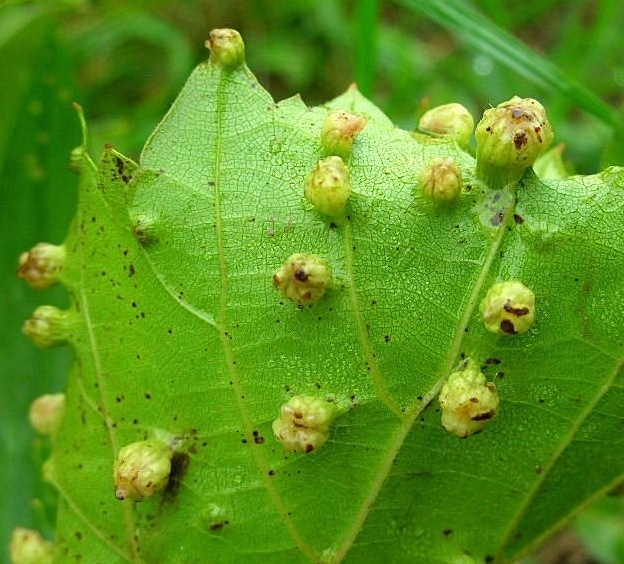
Phyloxera lays eggs in special sacs (galls), which are formed from leaf tissue under the influence of enzymes secreted by aphids when it bites
The situation with the root form of the grape aphid is much worse. To date, there are no drugs that destroy this pest. Growers living in regions where the soil is contaminated with phylloxera have only one choice - to grow Galahad grafted onto aphid-resistant rootstocks. These include the following varieties:
- Cober 5 BB;
- Ferkal;
- CO4;
- Vierul 3;
- PP101-14;
- Andros;
- Bucko Noir.
It is much easier to protect Galahad berries from birds. To do this, it is enough to throw a fine mesh over the vine or hide the bunches in bags sewn from it. Other methods of control, for example, scarecrows and shiny ribbons, according to winegrowers, are not effective enough, since after a few days the birds get used to them and continue to feast on the harvest.
Pruning and preparing for winter
Annual pruning is one of the compulsory agrotechnical measures in the cultivation of Galahad. It is carried out in the fall, immediately after the end of the growing season. 6-8 eyes are usually left on one vine, while their total number per bush should not exceed 40.
In regions with winter temperatures below -26 ° C, Galahad needs a mandatory shelter. For this, the vines are removed from the trellises and laid on the ground or in shallow trenches dug in advance. From above they are covered with a material that allows air to pass through well. For additional insulation, the vines are covered with spruce branches or covered with wooden shields.
After the establishment of a snow cover, a high snowdrift is formed over the covered grapes. Its condition is monitored throughout the winter and, if necessary, the fallen snow is raked up to it, while breaking the resulting crust, which prevents the penetration of air to the plant.
In the spring, the shelter is removed only after a stable above-zero temperature has been established. With a high probability of recurrent frosts, several holes are made in the material to ventilate the plant and avoid damping off, and completely remove it already during bud opening.
Advantages and disadvantages of the variety (table)
| Advantages | disadvantages |
| Quite high winter hardiness | |
| The presence of immunity to mildew, powdery mildew and gray rot | In the northern regions needs shelter for the winter |
| Good taste | Berries not harvested in time in the bright sun quickly become covered with dark spots |
| Large size of berries and bunches | Lack of resistance to phylloxera (grape aphid) |
| No tendency to cracking and shedding of fruits | |
| Good tolerance for transportation and long-term storage | |
Winegrowers' reviews about Galahad
Last year, I didn't like Galahad's taste (probably it rained a lot), but this I appreciated him. Good pulp, at 10.08. ripe, although I have been eating it up for a long time. Came under the spring frost, so there are few bunches. But what a potential it has! Ties 3 bunches on stepchildren. She left something, it will ripen.
Galahad has its drawbacks. Each berry has 3-4 seeds of a fairly decent size, the skin of the berry is quite dense. Last year saw wilting of the lower part on separate bunches. But I never observed cracking of berries on it. Pollination is excellent even this year. I have never seen peas on it, while the bunch is always of medium density, well built. The growth force is very great. The yield is very high, and requires mandatory rationing. Ripens very early. But it picks up its optimal taste if you let it hang a little. At the same time, the taste becomes very pleasant, a varietal aroma appears (but not nutmeg). The berry is milky white, from the illuminated side it gains a golden color. There was never any thought of removing this variety.
I like Galahad for its reliability and stability. Easily transfers any load. Thoughts to part with him have not yet arisen.
And Galahad upset me. Nothing outstanding. Medium bunch, weak taste, sunburn on berries, thick skin with fleshy juicy pulp.
And the ripening period is definitely later than Super Extras.
P.S. To be fair, I will add that it is on Kober. Maybe the stock affects the flesh this way.
Muscat, of course not, but the taste is one of the most memorable. For me it is a bit like duchesque - there is both sugar and refreshing sourness. One of the most stable, tasty, sustainable, and the size is not small.
For me, it’s very tasty, but it needs to hang longer. It becomes the color of milky yellow amber, the berries are large, fragile, the taste will not leave anyone indifferent. Even in comparison with nutmeg varieties, it does not lose at all.If we add that the variety is problem-free both in terms of diseases (it pulls for me without professional treatments), and vine ripening and load, then we can say that the variety (or GF?) Is outstanding. In September, I approached him first of all, to see if the sweets were lost among the foliage. Now I have something to compare with, more than 50 varieties and GF bear fruit. And Galahad would rank in the top five in all respects.
He also planted his Galahad one of the first in the vineyard - now there are 5 bushes. Several years ago, before increasing the bushes, I chose from Galahad and Super-extras as white ultra-early grapes. After several fetuses, he chose Galahad.
Under my conditions and agricultural technology, it is medium-sized, at the same time it pulls the harvest normally, the first bunches ripen in tenths of August, mass ripening - August 15-25. Yes, Galahad loses in taste (although I personally really like this taste with sourness) following him to Brilliant, Veles, even to the Transfiguration, but its main advantage is its ultra-early maturity and excellent productivity. , Galahada was the first to give seedlings because of its trouble-free growing - good resistance to diseases, high productivity, beautiful and large clusters.
The unpretentious Galahad grape variety can easily be grown even by a novice gardener. For a small amount of attention and care, he will surely thank his owner with delicious sweet berries ripening at the very beginning of the grape season.
